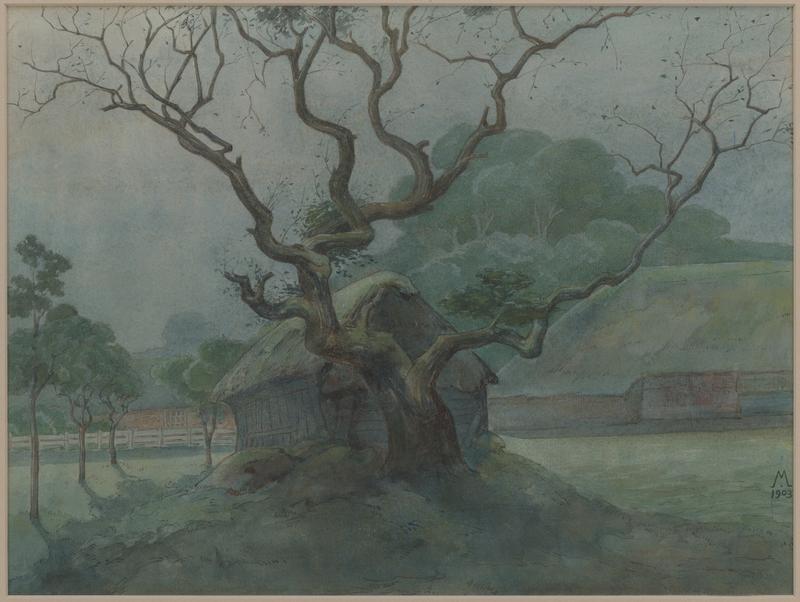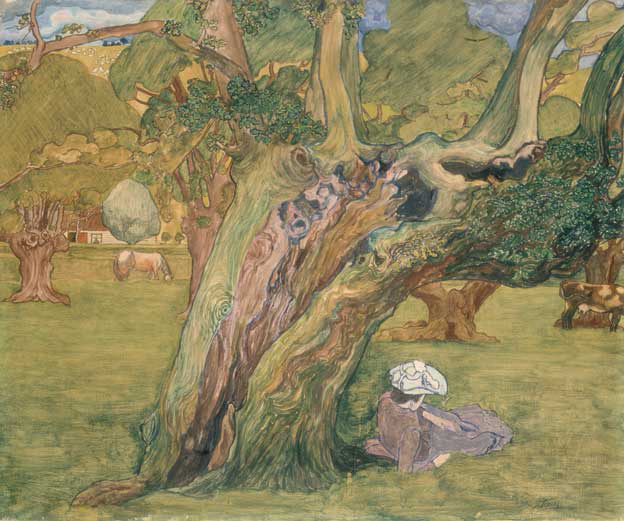
146. Simon Moulijn, Farmyard with Old Tree
| Artist | Simon Moulijn, Dutch, Rotterdam 1866–The Hague 1948 |
| Title, Date | Farmyard with Old Tree (Boerenerf met oude boom), 1903 |
| Medium | Watercolor |
| Dimensions | 14 3/4 × 11 in. (37.5 × 28 cm) |
| Inscriptions + Marks | Lower right: M / 1903 |
| Provenance | Heirs of the artist; [Hein A.M. Klaver Gallery, Baarn, Netherlands, until 2017; to Weisberg]; Yvonne and Gabriel Weisberg, Minneapolis |
| Exhibition History | "Reflections on Reality: Drawings and Paintings from the Weisberg Collection," Mia, 2022–23 |
| References | Erik H. Ariëns Kappers, Maarten Bunt, and Jan Jaap Heij, "Simon Moulijn 1866–1948" (Assen, Netherlands: Drents Museum, 1989), no. 44, p. 34 |
| Credit Line | Promised gift of Gabriel P. and Yvonne M.L. Weisberg, Minneapolis |
Mostly, the Dutch artist Simon Moulijn produced landscapes. Born in Rotterdam and trained at the Rotterdam Academy of Arts, then at the Rijksakademie van beeldende kunsten (State Academy of Fine Arts), in Amsterdam, he continued to refine his art while traveling from city to city in the Netherlands and beyond, sometimes sharing a studio with other artists. Moulijn became closely acquainted with the Dutch artist Ferdinand Hart Nibbrig (1866–1915), with whom he founded a painting school in Laren, in North Holland, in 1910.
International audiences discovered Moulijn in 1895 when Siegfried Bing held a retrospective exhibition of his work at his Art Nouveau gallery in Paris. The show revealed that Moulijn was working in a manner suggestive of the symbolists in France and Belgium. Brooding and mysterious, his work shows affinities with the writings of the Belgian author Maurice Maeterlinck and the paintings of the Dutch artist Jan Toorop (fig. 1). In the 1893 print Evening (cat. no. 145), one of Moulijn’s first lithographs—he created nearly 200—we can see the artist’s early inclination toward simplified forms.

The present watercolor of a lone tree conveys a certain melancholy. The gnarled specimen resembles the ancient giants in the forest of Fontainebleau, near the art colony of Barbizon. Such trees were archetypal elements of the picturesque imagery that harked to an arcadian past. Here, the tree is a holdover from an earlier artistic age, reused in a modern landscape hemmed in by a white fence. As his career went on, Moulijn ventured further from the elegance of Art Nouveau to explore the depths of emotion in the symbolist mode.
GPW